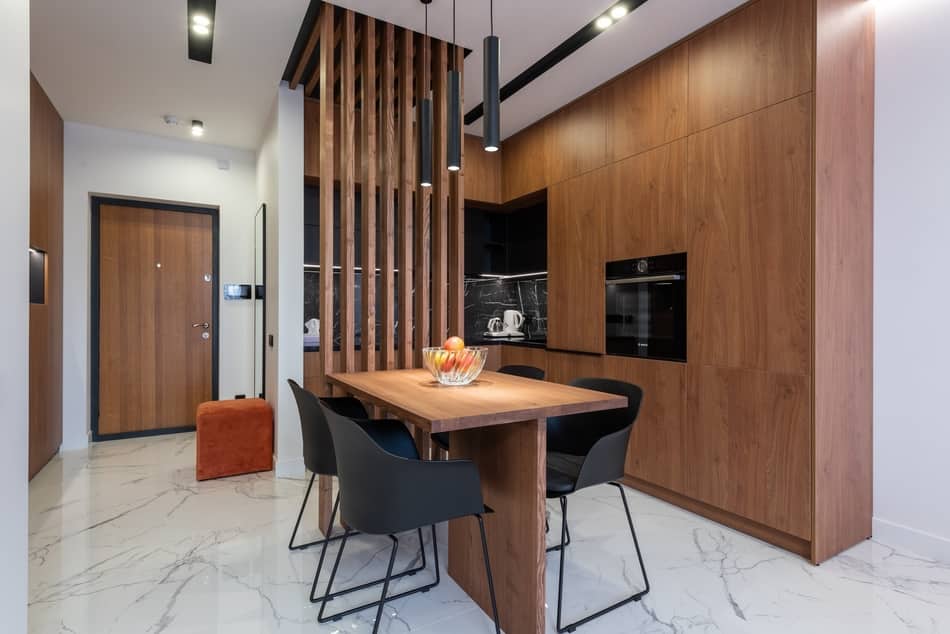The are many qualities that make marble floors very desiring. Its majestic natural look makes it one of the best construction materials for floors. But there are some odd circumstances that can turn the once beautiful glossy-looking floor into a dull uninteresting look and if you’re here looking for reasons why this happens, I’m going to share with you my research on why marble floors become dull.
So why do marble floors dull? Marble floors will become dull mainly from using the wrong marble cleaning products. Such products contain ingredients that will obscure the beautiful crystals and gloss that make your marble floors brilliant-looking causing them to look dull. One simple way of fixing this problem is by hiring a professional who will use high friction diamond abrasives equipment to restore the look of the marble floors.
This is ofcourse not the only way marbles become dull. In the remaining parts of this article, I’m going to share with you some of the common reasons why marble floors dull and tips to help you restore your marble floors to its original look.
1. Using Wrong Cleaning Products Can Dull Marble Floors
To expand on what seems like a summary in the previous paragraph, your marble floors will indeed from using the wrong kind of cleaning products. This is essentially one of the most common ways marble floors become dull.
Usually, the way you can tell if your marble floors are dull as a result of the cleaning products you use is by simply looking at how the marble floor has dulled.
If your marble floor has the entire surface becoming dull then it is most likely that the dulling has been caused by the cleaning products you use to clean or polish your floors.
This will usually be caused by purchasing and using conventional store-bought cleaning products for your marble floors. What you would want to go for are cleaners that are specifically designed for caring for and maintaining natural stones.
Using harsh cleaners and harsh sealants on your marble floors can cause the marble floor to seriously dull up and if you’re observant and you notice the adverse change on your marble floors in time, you would want to act immediately.
Tip: You would want to hire a professional to help clean and restore your marble floors as soon as you notice the change happening on your marble floors.
Usually, what you can expect the professionals to do on your marble is to make the marble floor shiny using high friction diamond abrasives or an industrial-size marble polishing machine.
2. Stains Can Cause Marble Floors To Look Dull
Marbles are known to be highly durable and long-lasting but this durable and elegant material is made from stone – so it stains very easily.
No matter how durable marbles are going to make your floors, they’re still going to be highly susceptible to stains – because marbles are very porous materials.
So having said this the dull overlay you may be having on your marble floors can be as a result of the marble floors having a lot of stains on them.
You will be able to differentiate between dulled marble floors caused by using wrong products and dulled marble floors caused by stains is by looking at how widespread the dulling is.
If there are only a few dull areas on your marble floors then it is likely your marble has become dull due to stains. However, if the dull areas on the marble floor are on almost every part of the marble floor, then it may have been caused by an application of some bad cleaning, polishing, or sealing product.
3. High Traffic Areas Of The Marble Floor Will Dull
Another way your marble floor may have become dull will be from the marble floor getting a lot of traffic. Areas of the marble floor that sees a lot of footsteps will likely dull quicker from frequent use.
In this case, you will notice that your marble floors around your main entrance, bedrooms, corridors, and sitting areas will most likely have more dull spots than other less-used parts of the marble floors.
Those high foot traffic areas of the marble floors will begin to get eaten away while losing their original surface shine.
While many will assume marbles are made from stones and so will attribute a lot of durability to them, it’s important to know that marble as a material is a pretty soft stone that can wear out easily from regular use.
4. Dirt & Grime Can Dull Marble Floors
If you allow your marble floors to accumulate too much dirt it can also affect the shine you’re supposed to have on the surface of your marble floors.
How? The way this will happen is that if you allow your marble floors to become very dirty without cleaning them timely and regularly the dirt build-up can clog the beautiful crystals that usually reflect light to give off the bright glossy surface we all love about natural marble floors.
So when you begin to notice dull areas on your marble floors you may need to take a closer look at the surface. Chances are the floor becoming dull may be as a result of dirt that is obscuring the shine of your marble floors.
Tip: The good news is if it happens that it is dirt or some sort of grime that is causing your marble floors to become dull then you can simply clean your marble floors with a good marble cleaner and your marble floors should have their sparkly bright look back.
5. Bad Cleaning Mops
The type of mops you use to clean your marble floors can also make your marble floors clean or cause them to have a dull look. This will particularly happen when you use the spray and mop type of mops.
What you would want is a mop that you can easily rinse and continue mopping. You can also go for untreated dust mops that are also great for your regular day-to-day marble floor cleaning and maintenance.
By doing so, you would be able to maintain the look of your marble floors for many many years without the marble floor becoming dull.
6. Marble Floor Exposure To Acids
Acids are one of the arch-enemies of marbles. When your marble floors get exposed to foods, drinks, or cleaner with a lot of acids in them like tomato juice, orange juice, or vinegar can cause your marble floors to dull.
This will be common around kitchen marble floors and marble floor areas around the dinning areas.
This will definitely be the case if you do not clean up immediately after you spill drinks or food on your marble floors but allow the acids to sit on the marble floor for a long time.
This particular damage will occur because as mentioned before, marbles are very porous and so their exposure to such acids is a definite recipe for disaster.
7. Using Improper DIY Cleaning Solutions
While loads of people are going to get their marble floors dulled up by using the wrong marble cleaners, others are most likely to unknowingly dull the surface of their marble floors by mixing the wrong cleaning concoctions for their marble floors.
A typical example is a vinegar. Using vinegar on your marble floor or any type of marble surface is definitely going to cause your marble floors to dull up, etch, or stain.
This is because vinegar contains acids that can disrupt the appearance of your marble floors even within a very short period of its exposure to it.
Same way, you should never use bleach, among other acid base home remedies for your marble floors. you would normally use for your marble floors.
Tips On How Polish And Prevent Marble Floors From Becoming Dull
- To make your marble floors shiny, there are two main things you need to keep in mind. Keep a regular cleaning schedule for your marble floors and always polish them after cleaning.
- If you find your marble floors are dirty or stained, you will need to apply poultice or sand it if you’re handy. Below are a few tips to help you maintain the look of your marble floors so that they do not become dull.
- Always clean your marble floors by first using a soft dry cloth or brush to remove any surface dirt, dust, or debris.
- If you need to scrub off any stains from your marble floors wet a non-abrasive sponge with warm water, wring it out and wipe the marble floor.
- You can buff the using chamois and a suitable natural stone or marble polish to give your marble surface a shine.
- One of the greenest alternatives to cleaning your marbles is to make a mixture of mild dish soap and warm water using a ratio of 2 drops of dish soap to about 8-10 ml of warm water.
Spray the marble surface with commercial stone cleaner and wipe it off with a clean, soft rag.
- You always want to rinse your marble surface with clean water or a solution comprising one part hydrogen peroxide to two parts tap water.
- To put a shine on your marble surface, rub a non-abrasive rag or cloth in a small circular motion.
- If you will have to sand your marble for any reason, you would want to precede the sanding with a few squirts of water and ensuring the marble surface is consistently wet as you sand.
- When sanding your marble, start by using 120-grit sandpaper and then follow up using a 300 grit sandpaper and then finish off with a 600 grit sandpaper for an even sanding process.
- You can use the 120, 300, and 600-grit sandpaper with a sander or manually by wrapping around a piece of the sandpaper around a piece of wood to create a sanding block.
You can use a damp cloth to remove debris or dust after sanding your marble.
- Always reseal your marble after you have sanded it.
- You can go for stone-specific commercial sealing products. My personal choice of commercial sealing products for marbles and other natural stones is an oil-repellent sealer. I like these types of sealers because they usually come with up to 10 years of life expectancy.
- Always use your marble sealers following the application procedures indicated on it package.

